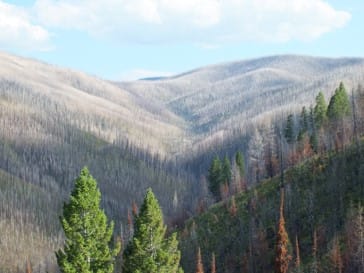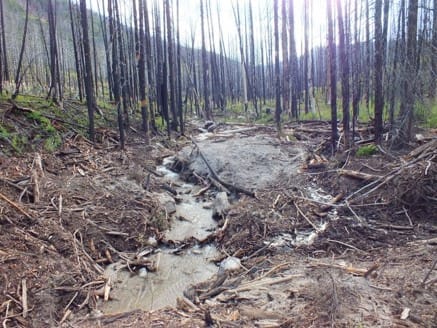The Cornerstone of Clarity
Evergreen exists for one reason: to make complex forest science understandable without stripping it of truth. This year, much of

Pat Connell and I have been friends for more than 25 years. We met when he was Rocky Mountain Log Homes log buyer during the heydays of log home manufacturing. After the Forest Service's Region 1 timber sale program imploded, he negotiated a log supply agreement with the British Columbia Ministry of Forestry that kept Rocky going for another 10 years. Rocky is still in business but the mortgage crunch has killed about 90 percent of the log home market.
Connell graduated from the University of Montana School of Forestry [BS Resource Conservation] in 1973. His baccalaureate thesis spoke literally and figuratively to the road he would travel in his professional life: Atmospheric static as a method for predicting localized lightning storms.
Following graduation, he worked for three Montana lumber companies: American Timber, Olney, St. Regis Pulp and Paper, Libby and Brand S, Livingston; then as a log home manager in Idaho before returning to Montana in 1988 when Rocky Mountain hired him as Resource Manager/Log Buyer.
He was promoted to Vice President, Resource Operations in the early 1990s but left the company in mid-2009. By then it was clear that subprime mortgage rates had created a housing bubble that would soon obliterate the log home industry.
The post-Rocky Pat is a Licensed Commercial Pesticide Applicator. Since 2012, he's been working with Bitterroot Valley landowners who are trying to control the spread of noxious weeds on their property.
Pat made quite a name for himself in the Montana House [2011 and 2013 sessions] and the Montana State Senate [2015 and 2017] sessions. No one in either chamber ever had to wonder what he thought. He does not possess the political doublespeak gene. He's sorry if he offends you but that's how it goes sometimes.
He's particularly proud of his sponsorship of the 2013 Wildland Fire Suppression Act, which steered unspent state agency money into a special suppression fund, Montana's 2017 "Good Neighbor Authority" legislation, which authorized state workers to engage in federal projects. A companion, co-sponsored by Democrat Brad Hamlett, aligned Montana’s "Good Neighbor Authority legislation with federal legislation embedded in the 2014 Farm Bill.
The day Pat and I first met - probably Spring 1999 - he toured me through Rocky's mill about 40 miles south of Missoula, then drove me up and down Highway 93 from Hamilton to Darby. We must have passed at least 25 open-air log home assembly plants; everything from log peelers hunched over some of the largest spruce and lodgepole pine logs I'd ever seen to towering cranes that were being used to erect massive log home frames.
I haven't seen Pat for several years, but we have stayed in touch via email. He sent me the photographs you see here, including the remains of a female grizzly that probably had cubs with her. She died in a relatively small lightning caused fire in the Whitefish Range at the north end of Montana's Flathead Valley. I can't tell if the tree crushed her or if she died trying to crawl beneath it to escape the flames. There was no escape.

Of the remains of the bull elk [above] Pat said, "This scene radicalized me more than any other where wildfire is concerned. Millions of people have probably seen the infamous photo of the two cow elk trapped in East Fork of the Bitterroot River in August of 2000 surrounded by fire, but I wonder how many have considered the possibility that the same fate awaited them that befell the elk carcasses I found at Blackwell Corral in 1994."
I wonder too. Over the years, I've written many times about the searing heat of wildfires that are capable of outrunning birds in flight and the crushing force of flash floods that roll truck-size boulders down spring-fed creek beds that have been incinerated by wildfires.
Among the photos Pat sent last night were these two taken in the headwaters of Woods Creek on the West Fork District, Bitterroot National Forest in 2012. A year earlier a lightning caused fire near Horse Creek Hot springs on the neighboring Salmon National Forest rolled over the mountain after the Forest Service had watched its progress for a month. It destroyed the Woods Creek headwaters.


Memories of Woods Creek, the East Fork of the Bitterroot River and Blackwell Corral prompted Pat to also send me his testimony before a U.S. House Natural Resources forum in May 2021.
In his testimony Pat focused on prolonged drought - a killing force that often precedes catastrophic wildfire.
"Drought exacerbates life in general, and in particular complicates our efforts to manage our natural resources and produce our agricultural commodities," Pat said. "The flow of season-long water is of critical importance especially to western states, due to the very nature of our landscapes."
Pat's reminded forum participants that the 1897 Organic Act - which federal resource agencies now routinely ignore - stipulated that no forest reservation [national forest] could be created except to [1] secure favorable conditions for water flows and [2] furnish a continuous supply of timber for the use and necessities of the citizens of the United States."
Switch reels. Come forward 127 years and we have the Biden Administration and its resource agencies doing everything possible to undo the progress made by the four Presidents who built the national forest system from the ground up: William Harrison, the first 13 million acres set aside in a Forest Reserve; Grover Cleveland, an additional 26 million acres; William McKinley, the first seven million acres designed under provisions of the 1897 Organic Act and Teddy Roosevelt, 150 million acres in additions to what were then National Forests.
The tip of the Biden spear is the Administration's Draft Environmental Impact Statement proposing amendments to most of the nation's 128 National Forest Plans to align them with the Administration's politicized attempt to add about 22 million acres of Mature and Old Growth [MOG] forests to an already existing 74 million acre network of no-harvest reserves.
The plan is essentially a death sentence for MOG forests. Why? Because there will be no clear legal pathway that permits the kind of restoration work that can reduce the frequency, size and intensity of wildfires that have already killed about half of the nation's 193 million acre federal forest estate.
And what might this restoration work look like? It's thinning and prescribed burning, a science-based strategy that private, state and tribal forest landowners have been using on their ownerships for decades. We have hundreds of before and after photos that illustrate the benefits - many taken in National Forests. The resulting patchwork mosaics are visually very pleasing.
Forestry's many options help us restore and protect the things we love about our forests: wildlife, cool water, fresh air and a wealth of year-round outdoor recreation choices.
Nature's version of forest restoration begins with a preventable insect or disease infestation that kills countless trees before lightning, a faulty transmission line or a careless camper starts a half-million-acre wildfire that doesn't heal up for perhaps 200 or 300 years.
This timetable doesn't work well in a society that is so dependent on the riches our forests provide. But its ponderous pace reminds us that "Nature" doesn't give a damn about what we want or need from our forests. "Nature" is a bitch.
The Biden Administration's love affair with "Nature" is killing our forests and our elk, bears, deer, birds and on and on and on. Public anger has grown exponentially over the last three years. Thousands of Facebook pages, especially in Deep Blue California, affirm this truth.
You 100% tax-deductible subscription allows us to continue providing science-based forestry information with the goal of ensuring healthy forests forever.